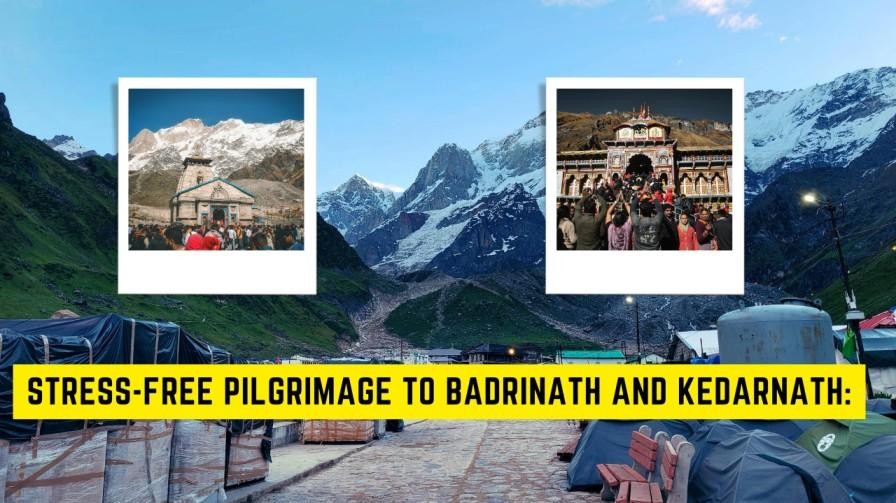A journey to Badrinath and Kedarnath is considered one of the most sacred pilgrimages in India. However, without proper preparation, it can easily become exhausting. To make the trip peaceful and fulfilling, it is advised that everything—from travel mode to accommodation—be planned in advance. When arrangements are made beforehand, the journey becomes less stressful and far more spiritually enriching. With careful preparation, the journey is not just about reaching temples but also about feeling divine energy throughout. Packing light, registering early, and choosing the best travel route ensures that the entire yatra remains organized and calm. As a result, the focus stays on prayers and peace rather than logistics or delays. Spiritual Importance of Badrinath and Kedarnath The temples of Badrinath and Kedarnath are regarded as two of the holiest shrines in Hinduism. They represent balance in nature—Vishnu as the preserver and Shiva as the transformer. Both are visited by millions of devotees every year to seek blessings and liberation from worldly attachments. Badrinath is associated with Lord Vishnu, who is believed to have meditated here amid the Himalayas. Kedarnath is dedicated to Lord Shiva, who is worshipped as one of the twelve Jyotirlingas. Together, they signify harmony between creation and destruction, devotion and detachment, and action and stillness. Moreover, both temples are surrounded by majestic snow-clad peaks, where silence and faith merge seamlessly. The serene environment allows devotees to experience an overwhelming sense of spiritual awakening. Badrinath – The Abode of Lord Vishnu Badrinath is regarded as a symbol of purity, preservation, and divine knowledge. It is believed that Lord Vishnu meditated here for thousands of years. The temple stands as part of the Char Dham Yatra, and visiting it is said to cleanse the soul and remove sins. Connection to Ancient Scriptures In several Hindu scriptures, including the Vedas and the Mahabharata, references to Badrinath can be found. It is mentioned that Lord Vishnu came here in human form to bless mankind. The temple’s history is so deeply rooted in spirituality that even today, chanting and rituals performed here are believed to purify one’s heart and mind. Energy of the Himalayas Surrounded by towering peaks and clear rivers, the region’s energy feels divine. It is said that nature itself meditates here. Pilgrims often describe that their worries seem to disappear as they step into the sacred valley. The sound of bells and the cool mountain breeze make the spiritual experience even more profound. Symbol of Devotion and Liberation Praying at Badrinath is believed to lead one closer to moksha—spiritual liberation. Many devotees say that true peace is achieved not by reaching the temple but by surrendering completely to the divine will. As a result, Badrinath is often described as a pathway to inner freedom. Kedarnath – The Abode of Lord Shiva The Kedarnath Temple, located at an altitude of 3,583 meters, is one of the most revered sites in Shaivism. It is believed that Lord Shiva appeared here to bless the Pandavas after the great war of Mahabharata. Every year, thousands of pilgrims visit to seek forgiveness and divine strength. Mythological Importance According to legends, the Pandavas searched for Lord Shiva to repent for their sins. To avoid them, Shiva transformed into a bull and disappeared into the earth at Kedarnath. The hump of the bull was left behind, forming the temple’s main shrine. It is believed that worshipping at this spot washes away one’s sins and grants eternal peace. Peace and Meditation Located in the lap of the Himalayas, Kedarnath offers unmatched serenity. The stillness of the mountains, combined with the chanting of mantras, creates an atmosphere of divine calm. Many devotees meditate here to feel closer to Lord Shiva’s energy, which is believed to be strongest at dawn and dusk. Path to Moksha It is often said that those who visit Kedarnath with pure devotion are freed from the cycle of birth and death. The journey is not easy, yet every challenge faced on the way becomes part of the spiritual test. As the soul surrenders to faith, inner transformation naturally follows. Combined Significance of Both Temples Visiting both Badrinath and Kedarnath together is believed to bring complete spiritual fulfillment. Lord Vishnu and Lord Shiva, though different in form, are considered two sides of the same cosmic truth. One represents sustenance and the other liberation. Therefore, devotees feel that both must be visited to attain balance in life. Moreover, both sites are located amid natural beauty, where rivers like the Alaknanda and Mandakini flow endlessly, reminding visitors of life’s continuity. The chanting of hymns, the ringing of temple bells, and the sight of mountains covered in snow together create an unforgettable spiritual experience. Best Time to Visit for a Peaceful Yatra The best months to visit are from April to June and September to October. During these months, the weather remains pleasant, and the temples are open for darshan. The post-monsoon period offers clear skies, calm surroundings, and comfortable trekking routes. It is advised that pilgrims plan their yatra within the recommended months to avoid natural challenges. How to Reach Badrinath and Kedarnath Both temples are well connected by road, rail, air, and helicopter services. By Road Badrinath can be reached from Rishikesh (314 km), Haridwar (298 km), and Dehradun (301 km).Kedarnath can be accessed via Gaurikund, which is 222 km from Rishikesh. From there, a 16 km trek or pony ride leads to the temple. Road travel is preferred by most pilgrims as it offers scenic views of valleys and rivers. By Train The nearest railway station is Rishikesh, well-connected to major cities.From Rishikesh or Haridwar, taxis and buses are available to reach the base camps. By Air The closest airport is Jolly Grant Airport (Dehradun).Helicopter services to Phata, Guptkashi, and Kedarnath are operated during the yatra season. For Badrinath, limited flights are available from Dehradun.It is recommended that seats be booked in advance as weather may affect flight schedules. Accommodation and Pre-Booking Booking accommodations in advance is highly advised. It helps in avoiding
Top 10 Lakes to Visit in Uttarakhand
Uttarakhand has many beautiful lakes that are calm and surrounded by hills and forests, making them perfect for nature lovers. Popular lakes like Naini Lake, Bhimtal, Sattal, Naukuchiatal, and Khurpatal are great for boating and relaxing. High-altitude lakes like Deoria Tal, Dodital, Vasuki Tal, and Roopkund offer stunning mountain views and peaceful surroundings. Tourists can enjoy nature walks, photography, and quiet time by the water. These lakes give a refreshing and relaxing experience for anyone visiting Uttarakhand. Naini Lake – The Heart of Nainital Naini Lake, nestled in the heart of Nainital, is a picturesque, crescent-shaped freshwater lake surrounded by lush green hills and colonial-era buildings. The calm blue waters reflect the surrounding oak, pine, and deodar forests, creating a serene and romantic atmosphere. On clear days, you can see the distant Himalayan peaks glistening beyond the hills, adding to its charm. The vibrant Mall Road runs along one side of the lake, dotted with cozy cafes, boutique shops, and heritage hotels, making the whole area lively yet peaceful. Activities You Can Do: · Boating (paddle boats, rowing boats, or yachting)· Lakeside photography and nature walks· Shopping on Mall Road and Tibetan Market· Trying local Kumaoni cuisine at lakefront cafes· Riding the Nainital Ropeway for panoramic lake views· Walking or cycling around the lake perimeter· Birdwatching near the lake edges, especially in winter Bhimtal Lake (Bhimtal) Bhimtal Lake lies in a peaceful valley just 20 km from Nainital, surrounded by pine-covered hills. Larger and quieter than Naini Lake, it has a small island at the center with a charming aquarium and café. The clear blue water sparkles in sunlight while migratory birds add life to the scene, especially in winter. It’s an ideal place if you love serenity and fewer crowds. Activities You Can Do: · Boating to the island café· Birdwatching during winters· Nature photography and quiet lakeside walks· Enjoying snacks at lake-view cafés· Kayaking and fishing (with permission) Sattal Lake (Near Bhimtal) Sattal, meaning ‘seven lakes,’ is a hidden gem of seven interconnected freshwater lakes nestled amidst thick oak and pine forests. The mirror-like waters reflect the dense green surroundings, creating a dreamy escape for nature lovers. Chirping birds echo in the silence, and mist often floats over the water in early mornings. The untouched environment here feels raw, wild, and truly away from the world, making it ideal for slow travel and digital detox. Activities You Can Do: · Kayaking and canoeing· Birdwatching (especially migratory species)· Landscape and forest photography· Forest trails and nature walks· Camping by the lakes Naukuchiatal Lake (Near Bhimtal) Known as the “lake with nine corners,” Naukuchiatal is surrounded by pine-clad hills and tranquil villages. The emerald-green waters are mesmerizing, and the place has an almost mystical calm. It is often less crowded than nearby lakes, giving you space to just sit and watch nature. In spring and winter, the lake is framed by blooming flowers or snow-kissed hills, creating postcard-like scenery. The peaceful atmosphere makes it a favorite for writers, photographers, and couples. Activities You Can Do: · Boating and paddle boating· Paragliding over the lake valley· Walking trails through surrounding villages· Spotting Himalayan birds· Sunrise and sunset photography Khurpatal Lake (Near Nainital) Khurpatal is a small, emerald-green lake cradled in dense pine forests, about 12 km from Nainital. Known for its clear waters and serene setting, it’s less commercial and feels more intimate, like a secret escape hidden in the hills. The reflections of green forests on the lake look magical in early mornings. It’s a place where time seems to slow down, letting you reconnect with nature in peace. Activities You Can Do: · Fishing (with local permission)· Scenic photography· Short forest treks around the lake· Boating in calm waters· Birdwatching Deoria Tal (Near Chopta) Deoria Tal is a high-altitude lake perched at 2,438 m, offering mirror-like reflections of the mighty Chaukhamba peaks. Surrounded by lush meadows and forests, it’s a magical place that feels like a painting. The air here is crisp and pure, and silence is broken only by birdsong and rustling winds. In winter, the whole area is blanketed in snow, giving it an unreal fairytale-like feel. Sunrises and sunsets paint the lake in golden hues. Activities You Can Do: · Trekking from Sari village· Lakeside camping under starry skies. Capturing mountain reflections· Watching sunrise over Chaukhamba· Birdwatching and nature walks Dodital Lake (Near Uttarkashi) Dodital is a tranquil alpine lake set at 3,024 m amidst dense deodar and oak forests. Surrounded by snow-capped peaks in winter, its glassy waters are said to be the birthplace of Lord Ganesha. The trek to Dodital passes through pine forests, bubbling streams, and wildflower meadows, making the journey unforgettable. The untouched natural beauty gives a feeling of total escape from modern life. Activities You Can Do: · Trekking from Sangamchatti· Camping by the lake· Trout fishing (with permit)· Nature and wildlife photography· Forest exploration Satopanth Tal (Near Badrinath) Satopanth Tal is a stunning glacial lake hidden at 4,600 m near Badrinath, surrounded by snow-laden peaks like Neelkanth and Chaukhamba. The turquoise waters and raw Himalayan backdrop make it one of the most scenic high-altitude lakes in Uttarakhand. The air is thin and cold, yet incredibly refreshing, and the silence is so deep you can hear your heartbeat. It’s challenging to reach, but the surreal beauty is worth every step. Activities You Can Do: · Challenging high-altitude trek· Remote camping· Glacier and mountain photography· Snow adventure (in season)· Stargazing Roopkund Lake (Chamoli) Roopkund is a glacial lake at 5,029 m, famously known as the ‘Mystery Lake’ due to ancient skeletons found at its bottom. It sits in a snow bowl surrounded by Himalayan giants, offering stark, dramatic beauty during the trekking season. The lake remains frozen most of the year, with snowflakes dancing on its surface. The entire trail offers alpine meadows, glaciers, and sweeping mountain panoramas. Activities You Can Do: · High-altitude trekking· Snow peak photography· Camping at base camps· Snowfield exploration· Sunrise views over Trishul peaks Mussoorie Lake



